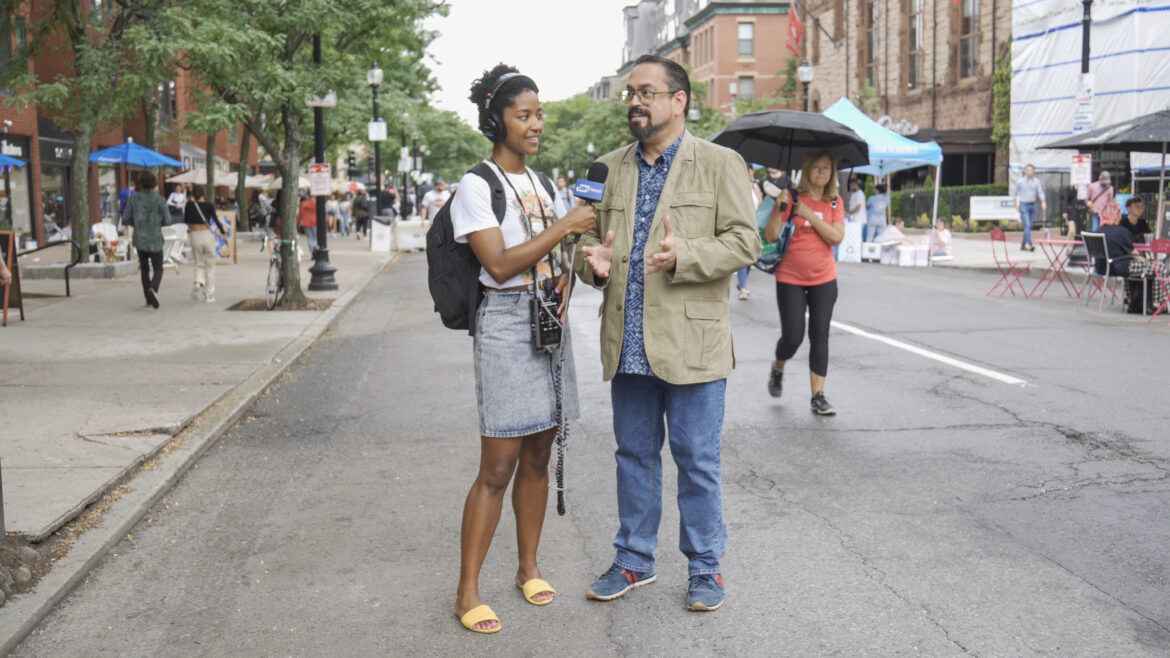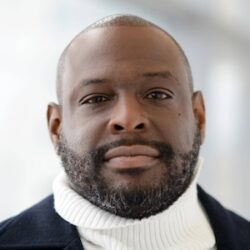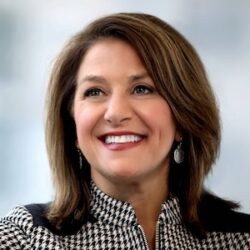GBH News sharpens focus on diversity and inclusion through Maynard Institute program

Jacob Garcia for GBH News
GBH "Morning Edition" co-host Paris Alston interviews Jay Calderin on Newbury Street.
GBH in Boston has started down a new path in its DEI journey.
As part of a pilot unveiled in February by the Robert C. Maynard Institute for Journalism Education, GBH News is one of two media organizations to participate in its new Equity and Belonging Newsroom Transformation Program. (The other participant is The Gazette, a newspaper in Cedar Rapids, Iowa). Through the pilot, which began last month and runs through June, GBH News leaders and staff are working with DEI consultants from the Global Equity Collective to help transform their workplace into a “newsroom without walls” that is “audience-focused” and “radically inclusive.”
GBH News started by reimagining its beat structure in ways that encourage staffers to learn new skills, such as versatility in multimedia reporting, which can help the newsroom cover more local topics.
Beyond expanding the scope of its local coverage, GBH aims to build a more diverse newsroom. By 2027, it aims to recruit and retain a news team that more closely mirrors Boston’s demographics.
Right now, 80% of GBH News staff are white and 20% broadly identify as being Black, Indigenous or people of color, according to Sam Brewer, GBH spokesperson. U.S. Census data from July 2022 estimated that Boston’s population is 50% white, 23% Black, nearly 20% Hispanic and nearly 10% Asian.

“We are trying to make our newsroom, our reporters, our newsroom leadership team — which right now is mostly white — we are setting a goal to add more diversity,” said GBH News Executive Editor Lee Hill. “This doesn’t mean we’re trying to fire all the white people. It just means that we’re trying to broaden the circle of who we’re doing journalism with and for.”
“One of the reasons we set the year for 2027 is because this takes time,” Hill added. “It’s not a goal we can achieve overnight.”
‘This is very challenging work’
Hill said GBH News created two working groups that will focus on “equitable professional development and belonging.” Like other public media organizations, last year the GBH newsroom implemented a system for tracking the diversity of the sources included in its coverage. GBH News collects data on the race, gender, age and location of its sources.
When Maynard unveiled the pilot in February, Co-executive Editor Martin Reynolds said in a news release that the institute wanted to “operationalize the concept of belonging.”
“This is very challenging work” because it requires newsrooms and individual journalists to address “internalized biases and perceptions that have made news organizations toxic places for so many, particularly people of color,” Reynolds said. The John S. and James L. Knight Foundation invested $1.2 million in the DEI program in 2019.

Pam Johnston, GBH GM for News, said the Maynard program launched at the perfect time. She had already developed a “North Star” vision for the changes she wanted to make in the newsroom. The pilot “clicked every single box of what we were trying to achieve and that we were working on already,” she said.
GBH is among the largest public media organizations to implement diversity, equity and inclusion practices since 2020. In 2021 it hired its first chief diversity and inclusion officer to oversee DEI work. Last fall its Nova production unit hired a science and equity editor to better include “the perspectives of historically excluded groups.”
‘Not lip service’
When newsrooms are intentional about the ways they cover communities and are honest about where they can do better, bigger changes happen, said Felecia Henderson, director of cultural competency for the Maynard Institute and co-leader of the pilot.
The goal of the Maynard program is to help participating news organizations become workplaces “where people can … really feel a part of a team and be who they are without fear or repercussions because of the way they may wear their hair or the accent they may have,” she said. “When you feel that confidence and support from your newsroom, you can go out into the community” and do good journalism.
Paris Alston, co-host of NPR’s Morning Edition on GBH, has already worked on one project that exemplifies the inclusive, “newsroom without walls” work GBH News wants to do going forward, she said. Last year, Morning Edition EP Karen Marshall encouraged Alston to develop ideas for a reporting series on subjects she wanted to cover.
“My reporting interest surrounds identity, community and culture, so I wanted to find a way to do that and continue this exploration of Boston neighborhoods and people who make them up,” Alston said.
Between May and October 2022, Alston reported a six-part series called “A Walk Down the Block,” in which she interviewed people from different Boston communities about issues that were affecting their quality of life. The series kicked off with a seven-minute segment about Boston Uncornered, a nonprofit that works to reduce gang violence by helping people get into college.
With support from GBH’s audience engagement team, Alston later met with interview subjects from Boston Uncornered and other community members to gather their feedback on the segment. Later installments of “A Walk Down the Block” reported on LGBTQ rights, homelessness, fashion in Boston and how neighborhoods are changing. Alston is developing ideas for a follow-up series.
In rethinking the newsroom’s beat structure, the goal is to empower staff to “report on all the interesting things happening in this region through a lens of equity,” Hill said. “Who’s winning, who’s losing, and what are the systemic and institutional barriers that are fueling these disparities and gaps.” This conceptual framework can be applied to education, local procurement, politics and policy reporting, he added.
“This is not intended to be nor should it be lip service,” Alston said. “It’s about saying that, okay, if we’re a public media organization, we need to focus on that word ‘public’ pretty heavily.”






Paris Alston is the most professional, smooth, attentive and charming media personality I have ever seen. (And obviously very photogenic.) The sky is the limit for her.